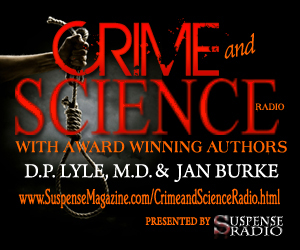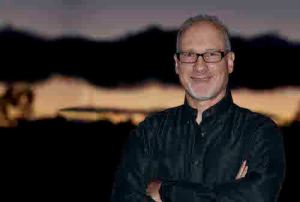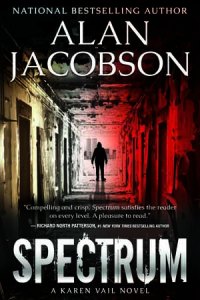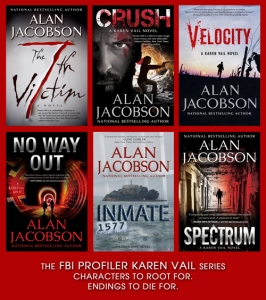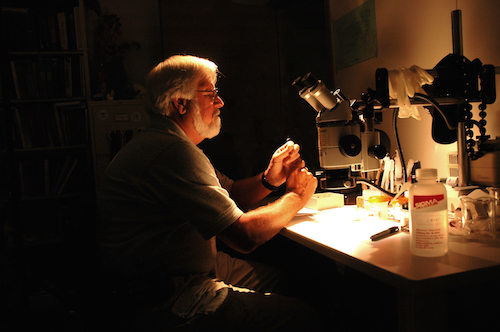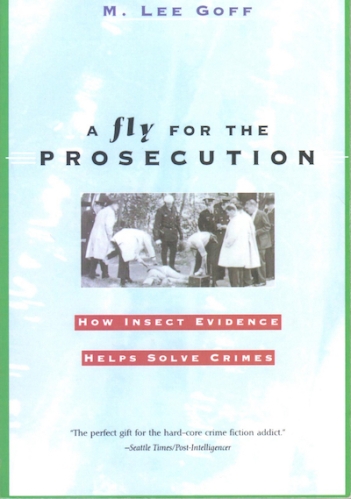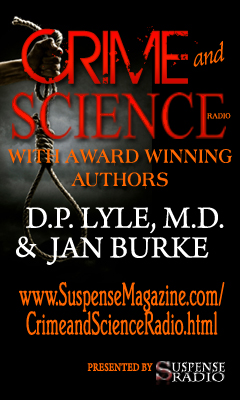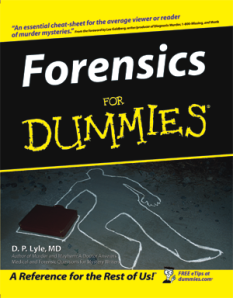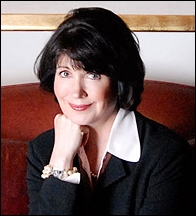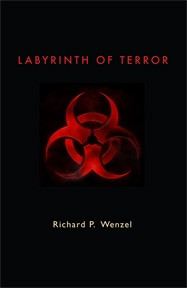
Courtesy of SUSPENSE MAGAZINE May/June/July 2018

Marcia Clark: Judging Evidence
Interview by Jan Burke
Listen to the Interview
Former Prosecutor Marcia Clark is a person most people know. Whether you are an avid reader of thrillers and have been enjoying Marcia’s fantastic character, Rachel Knight; or you are one who is interested in the world of crime and punishment; or even if you are one who loves sitting in front of TruTV to watch high-profile cases play out in the courtroom, Marcia Clark has become a household name in one way or another.
Recently, Marcia sat down with Jan Burke, host of Crime & Science Radio, to have an in-depth discussion regarding all areas of law and order. From the rules of evidence to some of the ways forensic science is used in the plots of her riveting legal thrillers, everything is covered.
Jan Burke (J.B.): Thank you for joining us, Marcia. Today we’re going to talk about some of your experiences as an attorney, your books, and the perceptions and misperceptions people have about the law, evidence, and science in the courtroom. To begin, how old were you when you decided to become an attorney?
Marcia Clark (M.C.): I did not start out to be one, actually. I took Poli Sci as an undergrad and soon found out the degree was basically worthless…
J.B.: I majored in the lucrative field of history, so I completely understand.
M.C.: I thought I was going to work in the State Department in the foreign office, which is what I wanted to do. And because I spoke various languages, I thought they would find that useful. Instead, they asked me if I could type. They really don’t like girls. I know a woman who works in the State Department now who says they still don’t like girls, so that’s interesting…
I floated around for a year or two and wound up saying: “Lawyer. I think that works.” And I applied at the last minute to law school and took the LSAT, hung over. I wasn’t exactly your most devoted fan of the law, but I became one.
J.B.: So you weren’t one of those people who in second grade stood up and said, “Objection!” to their teachers?
M.C.: I said all kinds of things to my teachers, actually, but not that one. That would have been a nicer one. But that’s a story for another day, Jan. When I was a kid I wanted to write. I liked writing, I liked acting, but I didn’t have faith in my ability to earn money doing either one of those, so…
J.B.: Which law school did you attend?
M.C.: Southwestern, here in Los Angeles.
J.B.: And ended up working in defense?
M.C.: Yes, I started out as a criminal defense attorney. No way was I going to work for “THE MAN.” The thought of being a prosecutor never even entered my head. I clerked for a defense firm for about two years and then I worked as an associate for about a year and a half. When it came to the point where it seemed I was always defending violent criminals, I realized that I’d rather prosecute. In fact, I felt like I did not want to practice law anymore at all unless I was a prosecutor. So when I went in for my interview, the D.A. at the time was John Van de Kamp, I told him that I thought I was done with law if I couldn’t be a prosecutor.
J.B.: So, you’ve worked in this field for quite a while and created Rachel Knight in your books. In what ways does the real life of a D.A. differ from what you see in books and on the screen?
M.C.: One thing for sure, is when it comes to books or TV, we all cut out the boring parts. Writing motions, doing research…not really sure how you could take that and make it exciting. Reading. Yeah, she’s still reading…. Typing. Yeah, she’s still typing…. We cut out all of the necessary but boring routine stuff.
A D.A. is out in the field more, especially when speaking of the special trials unit. The thing with special trials is that we pick up the case the day the body is found, which means we’re out on the streets with the cops and detectives a lot. We interview all witnesses on every case. I never took a case to trial without talking to all witnesses first—outside; where they were—especially at crime scenes if I could, so they could walk me through, show me what they saw, where they saw it from, etc. That usually put me in a better position in court.
J.B.: That is a whole different level, the special trials unit for the L.A. County D.A.’s Office. I’m assuming this is a division that not every jurisdiction has?
M.C.: Or even every prosecutor. In L.A., the thing unique about special trials is we do that kind of vertical prosecution from the bottom up. Because they handle all the high-profile, complex cases, they need that time to go out in the field and get that information. Most prosecutors get the ordinary cases very shortly before the jury trial commences, which counts for the pressures that are most common. Other jurisdictions do it differently. I’ve heard New York actually does have, as a matter of routine, the prosecutors going out in the field with the detectives. I don’t know that’s true, but since everyone does things differently I would imagine the bigger offices where there is more crime would have less opportunity to do that. Because it would require an office with a lot of prosecutors to be able to do this kind of prosecution. The D.A.’s office in L.A. is the biggest in the world. Makes sense, the county is huge. If it were a state it would be the 7th largest in the U.S.
J.B.: What would make it a special trials case? Would it be based on the high-profile and complexity of the case?
M.C.: Cases that will attract a lot of media attention. The Menendez brothers, for example, was a special trials case. Phil Spector. Those are the kinds of things that rate being a special trials case.
J.B.: We all have seen everything from L.A. Law to Law & Order, not to mention reading the legal thrillers out there. Can you name a few of the errors and clichés in those that make you go nuts. Such as, watching a legal drama where everyone in the room is riveted, yet you break out laughing because of the blatant error?
M.C.: You know what you and I have laughed most about is the forensic stuff they do. Like finding an eyelash in a field that can be traced to just one person. And I say, “Really? Out there in the field with the alfalfa you found an eyelash? Wow!”
They will also have those prosecutors arguing with the judge about what piece of evidence should or should not come in. You don’t really get to do that. They also strut around the courtroom which in real life most judges would never allow you to do. (Although some will, as we know.) There’s a certain level of showmanship for the sake of drama where an attorney will argue with a judge, whereas in real life the judge would say settle down. Not to mention the rulings. Judges offer rulings on TV that I wish in my wildest dreams I could get in.
J.B.: One of the things I’ve noticed with both the forensic science shows and courtroom dramas is the amazing amount of science that has not passed any rule of evidence I know about, getting in. I don’t even know if most people are aware of the rules of evidence. Not to mention the rules about what you can do to an arrestee to get a confession.
M.C.: Exactly. You really aren’t allowed to beat them with phone books. That cracks me up on TV, having cops out there beating the suspect up and getting a statement that will later nail him in court and all will be fine. Which, of course, would never happen; that is the anomaly. Cops, by and large, do not do things like that and do not get away with them if they do. You need to read them their rights, you need to get a valid waiver because you can’t get the statement in without it. And on TV the statements always come in so clean. The suspect admits or denies. Easy. But in real life, if you get the statement, a confession is a “yes, but…” An approach avoidance. “I did this but I didn’t do that.” Which means the best thing for the prosecutor is not to use it at all. Unless you think you can’t prove the case without it. They don’t show reality and I think if they did, and what the prosecutor has to do to overcome, it would make for a better story.
Then there’s the other thing you were talking about, the rules of scientific evidence. You don’t just get to put in scientific evidence because you want to. It has to pass muster. You usually have to have a hearing if it’s something new in the field. In the very beginning, when DNA was new, you had to have these incredibly long hearings where you had to show that the DNA testing methods were accepted in the scientific community. It was no easy thing to prove. So there are quite a few hoops to jump through before this stuff gets into evidence.
J.B.: The person in a show who has discovered some new way of processing something, like photo-manipulations, really drives me crazy. The court certainly wouldn’t like you bringing in doctored photos.
M.C.: And they won’t let you. Not to mention, the defense will object. Even if it’s just a blowup, the defense can and will look at it to see if it’s distorted in some way. You don’t just get to do whatever you want.
J.B.: In the real world there are these tests that must be done on evidence, so the judge is going to ask you to bring in experts. I assume the defense gets to bring in their experts to say something is not reliable or accepted?
M.C.: Yes, each side gets to bring in their experts and the judge must make a ruling; basically saying it is or is not reliable, or accepted by the community, or meets the standard for admission into evidence, which requires testimony from both sides before a ruling can be made. Towards the end of DNA acceptance, the defense was more and more getting into the position of, “Never mind calling the witness, it’s not worth it. It will just come in.” And they would just kind of make a record by cross-examining the prosecution’s expert. We’re at the point now when the DNA evidence does all come in, but there will be new methods of DNA testing that will require the same expert testimony before its allowed in, in the future. PCR testing was relatively new when we were working on Simpson and that required all kinds of hearings: you were allowed to use it to exclude people but not to identify.
J.B.: I think this week in the news they were talking about the third trial of some individual and how they had an expert at “touch DNA” who has apparently testified sixty times. That may sound like a lot, but when you look at the whole country, that’s not many trials. I think that is one of those areas when we speak about DNA and how small of an amount you actually need. I think a lot of people don’t understand forensic science. Things change. You can always find yourself feeling very sure about something in one decade, and yet a decade later it changes. I know the FBI goes through this with everything from hair evidence to bite marks; they even once thought fingerprints could be challenged?
M.C.: They don’t get too far with that, however, because proving two people have identical fingerprints is quite a reach. And fingerprinting has been around so long that if we really had a problem with people having identical fingerprints, we would have seen this happen by now. The fingerprint databases are so huge; they’re vast, in fact, and we aren’t finding people with the same fingerprints.
But with DNA being so new and the databases not nearly as vast, although they’re growing every day, the biggest challenge used to be that the databases were so small you could not justify that no two people could have the same DNA. Of course, as time moves forward, I think we are becoming certain of that fact. But the databases are still not nearly as big as the fingerprint databases.
J.B.: I think a lot of people have, for better or worse, watched trials on TV and probably noticed that there will be experts that contradict each other. How do you choose your forensic expert, or do you live with the guy the lab sends over to you?
M.C.: Usually you have to live with the guy they send over to you. LAPD has a crime lab and the one who is assigned to you is the one you get. The only time you might get to choose outside that box is when their tech has a problem, can’t testify, or it’s a heavy-duty case. Not necessarily a high-profile case, but one that offers serious charges like murder. In that case, they might let you find another expert to back up what you have already done. Typically evidence goes straight to LAPD, especially now that they have a crime lab with a DNA lab up and running. Back when I began, before Simpson, we had to use Cellmark because the LAPD did not have a crime lab and were not set up to do DNA testing. Because there was such a big challenge in the Simpson case, we ended up sending our samples to not only Cellmark but also the Department of Justice. At one point, even before that, I wanted to agree to let the defense expert, Ed Blake, do the testing. I knew he was a good guy and we could share all of these results. But the defense didn’t want to share these results…
J.B.: Mmm. How funny…
M.C.: Typically, though, your jurisdiction has their own place. I think in the south part of California, in Riverside, they use Biotech. But whether it’s a private lab or one associated with the police station, you can reach outside that and get other experts—but only in very unique cases.
J.B.: When we see defendants in courtroom dramas, they are quite often suave, well-behaved, in suits. But I would assume they are not people who represent the “average bear” brought to trial. Tell us, in your experience, the criminal mind and demeanor of the types of people who came before you, more often than not.
M.C.: I love that, too, that they always have the cool, charming types. Not to say that type of defendant doesn’t appear, but it’s rare. That kind of defendant is normally a sociopath. They are not necessarily a serial killer, but they commit crimes for pleasure, fun, and sometimes for profit. That kind of defendant is more in control of the instrument than your typical defendant. Typical defendant is: Johnny tells Eddie, let’s go rob that liquor store, and then they grab someone’s gun and go do it. And then, BOOM! They get locked up immediately because they’re idiots and wind up in court. Typical of these defendants is poor impulse control, and that poor impulse frequently finds its way into the courtroom. They’ll give hard looks to witnesses, pop off and say things in front of the jury, yell at their lawyers, and basically do things that are bad for them.
J.B.: In a book or on TV you have to create a worthy antagonist. Not much of a story if it’s the Johnny and Eddie type.
M.C.: People ask me all the time about my books, “Are these the cases you handled?” I always say that if I told you the real story of real cases the book would be over in two pages. They went to rob a liquor store. BOOM! Story over.
J.B.: Let’s talk about legal terms. People hear words that have legal meaning that they misunderstand sometimes. (For writers out there, I recommend getting yourself a great legal dictionary.) For example, I see a lot of confusion between homicide and murder and between murder and manslaughter.
M.C.: And that is a really common one. Homicide means that you have an indication of criminal agency. Somebody died at the hands of another, but whether what they did falls under first degree, second degree, or homicide is a separate issue. Homicide just means that a criminal agency is involved in the murder; someone is dead and didn’t get there naturally. If this is not true, then it’s deemed a suicide. If it is a homicide, you then move to the question of what kind/type of crime it was. Was it murder? First degree means it was a premeditated murder; there was some planning before the act was done. But as the jury instructions will tell you, planning does not require any particular length of time. If I pick up a gun and say, “I’m going to shoot you,” and then do it, that’s premeditation. In that one breath, that’s enough; first degree is an intentional killing and doesn’t require any particular length of time.
Second degree can be a rash impulse. The kind of murder that occurs in the course of a fight or argument, which is not premeditated. Then you have manslaughter. Voluntary manslaughter is a killing where there is some type of mitigating influence. By that I mean, something that makes it less than murder. We are all familiar with killing in the heat of passion. For example: If you are in a bar fight and someone throws a bottle at you and you hit him over the head with a bottle and kill him, that’s most likely involuntary manslaughter. The other way you can receive manslaughter is if you believe, even if that belief is unreasonable, that you must defend yourself. Such as the George Zimmerman case. The theory behind this form of manslaughter is someone is threatening you and you honestly believe you need to defend yourself with force. But if it’s not a reasonable belief; there is no justification. This is called unreasonable belief in the need for self-defense. That, too, can get you manslaughter. Now if you have reasonable belief, that’s a complete excuse and you are not guilty of anything.
J.B.: And will you be the one collecting the evidence and coming to that conclusion? Who determines the charges to be filed?
M.C.: The decision on what to file is also something specific to the special trials unit. The ordinary cases go through what is called the “Complaints Division” downtown. In branch court, they’re called filing deputies. All they do is when the cops bring in their reports and say, “I want to file charges against Joe Smith,” the filing deputies look at the reports and decide what they have there and decide what charges to file. When you are in a specific unit, like special trials, the detectives come right to me and say what they want to file against Joe Smith, such as, we think he’s good for murder. I review the reports, what we have, and I decide whether or not I agree with the detectives and then file whatever charges I see.
J.B.: I’m assuming this can lead to tension? When the cops believe they have a case every time?
M.C.: Not all of them. Some are reasonable. They will come in and say it’s a little skinny now but review the reports and tell me what you think I’m missing. Frequently, in those situations, I do a reject pending. Which means I reject the case pending further investigation, but that means it’s not really rejected. I’m just saying go out and get more stuff. If you’re working with reasonable police officers and you’re reasonable, it’s fine.
On some occasions you will have someone chomping at the bit, snorting fire out of his nose, etc., who states: “I have Joe Smith for murder and you have to file this.” I have gotten into it on one or two occasions with detectives. Once they even went over my head and went to the big honcho and said, “I think we’ve got it and she’s wrong.” They backed me but, needless to say, it was a very uncomfortable time and a lot of tension and anger. They come in believing in their case and they should! Unless they come in and say they just need to show they’re working with a D.A. and looking for a reject pending which they’re fine with, that’s another story. But if they come in really believing there should be a specific filing, then they ought to be behind their own case. That’s why you need checks and balances. You can’t just have one person making all the decisions which is why it’s good to have a prosecutor on the outside saying, “Look, if I take this to trial the defense is going to say you’re missing x, y, and z.” For example, your eyewitness isn’t strong. Or he’s a gangbanger from the rival gang of the defendant who will say anything to nail the defendant, etc. Then they need to go find me corroboration.
J.B.: Getting back to some of those terms. What does reasonable doubt really mean? I think we’ve reached a point where people think anything can be proven with physical evidence. And that this evidence is always available, testing is available, and if you’re not bringing it in then you didn’t look hard enough for it.
M.C.: You’re right, it is a very big problem. You have these cases that get highly publicized with tons of evidence. There’s hair, blood, DNA, saliva—everything you can imagine and you have it all. That’s cool. But it is not common. First, not all crimes provide evidence; a burglary very seldom leaves you more than fingerprints and you rarely get those. Or you’re relying on an eye witness living down the street who got a glimpse of someone…good luck with that one. Juries have a skewed look at things. They believe we should always have DNA and a wealth of physical evidence. And maybe someday we will. Maybe one day evidence collection will reach the point where we will be able to get electro-static footprints out of dust, and all that cool stuff, but we’re not there yet. Most cases don’t provide such things and as a result juries wind up equating lack of physical evidence with reasonable doubt.
But, here’s the thing, Jan. I handle criminal appeals across the state of California from the northern tip to the southern tip now, so I have a better chance to see, overall, what juries are doing than I ever did before. I see them convicting without physical evidence all the time. But in other cases, juries may come in and decide they simply like a defendant more than they like the prosecution or the victim. I just handled a case, which was quite interesting, where they charged three defendants with murder and the three defendants came off better than the victims did. The jury ended up acquitting two and convicting the third on manslaughter. Ordinarily, a case like that where the victim is unarmed and the defendant went and got the weapon used, would have led to murder convictions across the board. But this jury did not cotton to the victim and it went the other way. That wasn’t about physical evidence or lack thereof at all.
That’s why reasonable doubt bothers me because it is a very elastic term. The problem is a jury can say reasonable doubt when really, objectively speaking, isn’t what they’re doing. What they are doing is converting “reasonable doubt” to “reason to doubt.” People find a reason to doubt that the sun is going to rise tomorrow. Apocalypse tonight and the sun doesn’t rise. That’s a reason to doubt. But is it reasonable? No. But that’s what happens with juries which is sometimes why you end up with odd verdicts. They come out and say there’s reasonable doubt and the people watching say, “What? There was a reason.” Well, you’re right, but the jury found a reason to doubt.
J.B.: Now, what does circumstantial evidence mean?
M.C.: Keeping it simple, circumstantial evidence is, say, a fingerprint. Why? Because you have to deduce from the fingerprint that the person who left that print is guilty of the crime. You didn’t see him do it, because that would be direct evidence, so that’s the short version of it.
J.B.: Which means most all evidence is circumstantial?
M.C.: Yes. Anything short of the defendant saying, “I did it,” or an eyewitness picking them out of a line-up is circumstantial.
J.B.: Here’s another one I believe people don’t quite understand: Legally insane.
M.C.: Here’s the thing. It is a very high standard to prove someone is legally insane. You have to prove they did not understand the nature or quality of their act, and that they could not control their behavior. Basically, they did not know what they were doing. You’re talking about a person walking into a bar, shooting three people, but actually believing that he was spraying flowers with insecticide. You know what I mean. It’s that level of disorientation or lack of reality in what he’s doing and very, very few criminals can meet that test. It is very rare. Legally insane really does mean a person who does not understand or appreciate the nature and quality of his act. And who does that really fit?
J.B.: So those sitting at home saying you must be crazy to want to take someone’s life…that’s not the standard.
M.C.: And if it were, you would have to rule everybody legally insane because what sane, rational person decides they have to kill somebody. No matter what that person might have done to you, do you really have to kill the person? We used to have a test in California a long time ago called “Irresistible Impulse.” That was where they said, if a defendant had an irresistible impulse and could not control himself and stop himself from committing the crime then he was legally insane. But the problem with that test is, was it really an irresistible impulse or was it just an impulse they didn’t resist? Well, isn’t that all crime? An impulse you didn’t resist?
J.B.: I am waiting for the day neuro-science brings us to a whole new understanding of how the brain works. We’re starting to see it now, in fact.
M.C.: True. They are doing some interesting testing now with the psychopath and showing the empathy center in their brain is inactive. There is really a physical difference between them and “normal” people that you can see.
J.B.: And they respond differently to various violent images, even differently from other criminals, even those criminals who committed violent crimes.
M.C.: Yes, people seldom appreciate that the psychopath is only 2 to 5 percent of the population. Very small; you would even call it statistically insignificant. The majority of criminals are not psychopaths. They’re messed up, don’t get me wrong, I’m not saying they’re the picture of mental health, but they’re not psychopaths.
J.B.: Just a couple left on my list. What about hearsay? People don’t understand that a lot of times.
M.C.: Lawyers don’t understand that one a lot of times, either. Hearsay requires its own study. Simply defined, it is a statement made out of court offered for the truth of the matter asserted. Even if you’re on the witness stand and you want to testify as to something you said to someone else during a crime; that can be hearsay. If you are not offering a statement to prove what you’re saying is true, then it’s not hearsay. For example: If you asked me, “Marcia, what are you doing?” That is not hearsay; that is a question. What truth are you asserting? There is nothing you’re proving with that statement. It might do other things, but what it is not is hearsay.
Generally speaking, we do have exceptions which is where the confusion comes into play. For example: If I am the prosecutor and a defendant made a statement during a crime like, “Lay down or I’ll shoot you in the head,” I am allowed to put his statement on. The witness is going to say that the defendant said, blah, blah, blah. And you are going to say that what the defendant said to the witness is hearsay so how can the witness testify to it? He can because it is a party admission. Under section 1220 of the Evidence Code, that statement comes in if the prosecution is proving it. The defendant cannot do that. If he wants to put in his own statements, he has to take the stand and find a way to put it in. He cannot elicit his own hearsay; only the prosecution can do it. So that’s where it gets confusing because you have all these exceptions where this side can bring it in and this side can’t, etc. That’s why there are a lot of arguments about it. There is no hard and fast rule when it comes to the hearsay rule.
J.B.: Another thing…plea bargains. People don’t often understand why attorneys go for plea bargains rather than trials. As taxpayers they should understand, but maybe you could explain a bit about why plea bargains are necessary to the system.
M.C.: Well, I believe that if we didn’t have plea bargains, the system would collapse. There is just no possible way to have the resources to take all cases to trial. I mean, there are thousands and thousands of cases. It boggles the mind just to think of how many are in the system in L.A. County, alone. Now, defendants want plea bargains because it limits their exposure. If they go to trial they face the maximum sentence possible for all of the charges they get convicted of. If that amounts to, say, 99 years to life, and the prosecutor says I’ll give you 25 to life, then yeah, he’s going to save himself the grief of going to trial and risking the (what we call) twelve-headed monster convicting him of everything.
We wish to thank Marcia Clark for taking time out of her busy schedule to do this in-depth interview. For those who wish to check out more about “Killer Ambition,” head to http://www.suspensemagazine.com. And take a moment to check out http://www.suspensemagazine.com/CrimeandScienceRadio.html where Marcia and Jan posted additional links. ■
Originally aired on Crime & Science Radio; October 2013.
